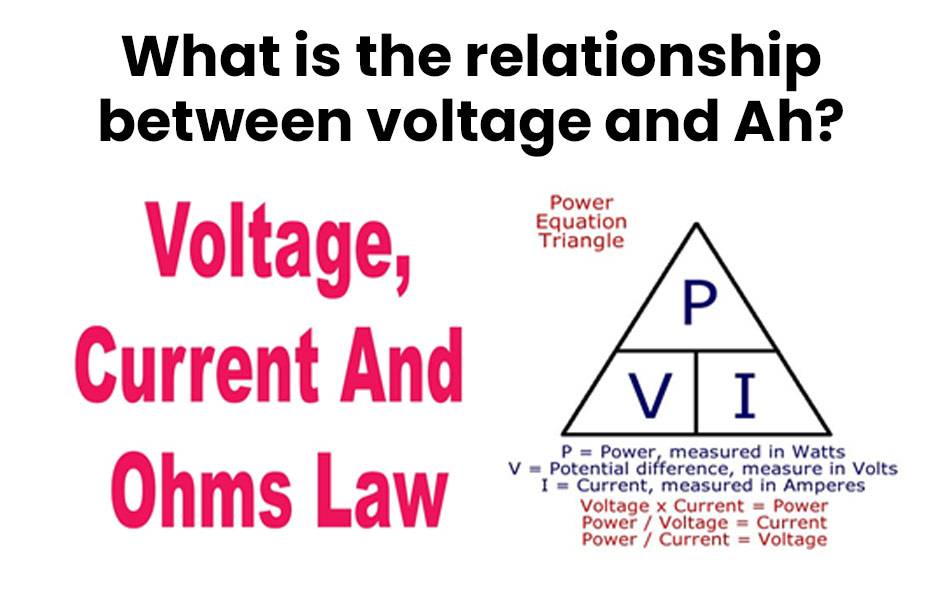Welcome to our blog post on voltage and ampere-hours (Ah)! These are two crucial concepts in understanding how electronic devices are powered and why battery performance varies. In this article, we’ll simplify the complexities of voltage and Ah, uncovering their significance and practical uses. Get ready for an enlightening journey through the world of electrical energy!
Understanding the Basics: Voltage and Ah
Voltage and Ah are fundamental concepts in electrical energy. Voltage, measured in volts (V), is the force that drives electric charge through a circuit, while Ah, or ampere-hours, refers to the battery’s energy capacity. Let’s explore these concepts further:
- Voltage (V): Voltage is like the “push” that makes electricity flow. It’s the pressure that drives the electric charge through a circuit, measured in volts (V). Higher voltage means more potential for power delivery.
- Ah (Ampere-Hours): Ah represents the battery’s capacity to store energy. It’s like the size of a bucket – larger batteries can store more energy. Ah is calculated by multiplying the current in amperes (A) by the time in hours (h) a device operates.
Understanding the relationship between voltage and Ah is crucial for choosing the right batteries for different applications. Whether it’s powering a smartphone or running industrial machinery, knowing these basics helps ensure optimal performance and longevity of electrical equipment.
The Relationship between Voltage and Ah
Understanding the relationship between voltage and Ah is essential for evaluating battery performance. Voltage measures the strength of an electric charge, while Ah indicates the battery’s capacity. Let’s explore this relationship further:

- Voltage (V): Voltage, measured in volts (V), determines the strength of an electric charge. Higher voltage means more power output for devices requiring quick bursts of energy, like cameras or drills.
- Ah (Ampere-Hours): Ah measures a battery’s capacity to sustain its output before needing recharging. A higher Ah rating implies longer-lasting power for devices with lower power requirements, such as flashlights or remote controls.
It’s crucial to consider both voltage and Ah when choosing a battery for your device or project. Simply multiplying voltage by Ampere-hours doesn’t accurately measure total energy storage capacity, as batteries have different discharge rates and efficiencies.
Factors that Affect Voltage and Ah
Several factors influence the relationship between voltage and Ah in batteries. Understanding these factors is essential for optimizing battery performance. Let’s explore some key considerations:
- Temperature: Lower temperatures can reduce battery voltage and overall capacity, impacting performance.
- State of Charge: As a battery discharges, its voltage decreases gradually. Therefore, the state of charge affects both voltage and Ah.
- Battery Type: Different battery chemistries have varying characteristics, influencing voltage and Ah measurements.
- Load: The connected load affects battery performance, with higher loads often resulting in lower voltages and decreased capacity.
- Age and Usage Patterns: Over time, batteries naturally degrade, and frequent deep discharge cycles can further reduce capacity.
Considering these factors helps in selecting the most suitable battery for specific applications and ensuring optimal performance over time.
How to Calculate Voltage and Ah
Calculating voltage and Ah (ampere-hours) is essential for understanding battery capacity and performance. Let’s explore the simple steps involved:
- Voltage Calculation: Measure the potential difference between two points in the circuit using a voltmeter. This measurement, expressed in volts (V), determines the battery’s voltage.
- Ah Calculation: Multiply the current (in amperes) by the time (in hours). This straightforward formula gives you the battery’s Ah rating, indicating its capacity.
Understanding how to calculate voltage and Ah helps us accurately assess a battery’s capabilities for various applications. Consideration of factors like temperature and discharge rate ensures informed decision-making when selecting batteries.
Applications of Voltage and Ah in Everyday Life
Voltage and Ah are integral to various aspects of our daily lives, from powering electronic devices to renewable energy storage. Let’s explore their practical applications:
- Powering electronic devices: Voltage determines the electrical current strength, while Ah indicates battery longevity for devices like smartphones and power tools.
- Electric vehicles: Higher voltage enables faster acceleration, and larger Ah extends the driving range in electric vehicles.
- Renewable energy storage: Batteries with high voltage and Ah capacity store excess energy from sources like solar panels for later use.
- Backup power supply: Batteries with adequate voltage and Ah provide backup power for critical systems during outages or emergencies.
- Portable lighting: Batteries power portable lighting solutions for outdoor activities, ensuring illumination on the go.
- Remote control toys: Battery-operated toys rely on voltage and capacity for efficient performance.
- Garden tools & Lawnmowers: Higher voltage batteries enhance the effectiveness of battery-powered garden tools like lawnmowers.
- Power banks: Power banks with sufficient voltage output keep mobile devices charged while on the move.
Understanding the role of voltage and Ah in everyday applications helps us make informed decisions about battery usage.
Choosing the Right Battery for Your Needs
Choosing the right battery involves considering several factors to ensure it meets your specific needs. Let’s explore these factors:
- Voltage Requirement: Identify the voltage needed for your device and ensure the battery’s voltage matches it for compatibility.
- Capacity Requirement: Assess your power consumption needs and opt for a battery with an adequate Ah rating, indicating its energy storage capacity.
- Application: Consider the intended use of the battery, whether for rechargeable or non-rechargeable applications, to ensure suitability.
- Size and Weight: Take into account any size or weight constraints to ensure the battery fits and doesn’t add unnecessary bulk.
- Operating Conditions: Evaluate environmental factors like temperature and humidity to choose a battery that can withstand the conditions it’ll be used in.
- Cost: Compare prices while considering other factors to find a battery that balances performance and affordability.
By considering these factors, you can select a battery that meets your requirements effectively and efficiently. Always refer to manufacturer guidelines for safety and performance recommendations.

